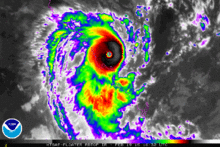Landfall

Landfall is the event of a storm moving over land after being over water. When a waterspout makes landfall it becomes a regular tornado, which can then cause damage inland. When a fair weather waterspout makes landfall it usually dissipates quickly as it loses the inflow of warm air into the vortex.
Tropical cyclone
A tropical cyclone is classified as making landfall when the center of the storm moves across the coast; in strong tropical cyclones this is when the eye moves over land.[1] This is where most of the damage occurs within a mature tropical cyclone, such as a typhoon or hurricane, as most of the damaging aspects of these systems are concentrated near the eyewall. Such effects include the peaking of the storm surge, the core of strong winds coming ashore, and heavy flooding rains. These coupled with high surf can cause major beach erosion. In low-lying areas, the storm surge can stay inland for a long time and mix with chemicals already in the area to create a toxic mess. When a tropical cyclone makes landfall, the eye closes in upon itself due to the weakening process, which causes surf to decrease. Maximum sustained winds will naturally decrease as the cyclone moves inland due to frictional differences between water and land with the free atmosphere.[2]
Landfall is distinct from a direct hit. A direct hit is where the core of high winds (or eyewall) comes onshore but the center of the storm may stay offshore. The effects of this are quite similar to a landfall, as this term is used when the radius of maximum wind within a tropical cyclone moves ashore.[3] These effects are high surf, heavy rains that may cause flooding, water buildup along the coast with minor storm surge, coastal beach erosion, high winds, and possibly severe thunderstorms with tornadoes around the periphery.
Tornado or waterspout
When a tornadic waterspout makes landfall it is reclassified as a tornado,[4] which can subsequently cause damage to areas inland of the coast. When a fair weather waterspout makes landfall it usually dissipates quickly due to friction and a reduction in the amount of warm air supplied to the funnel.[5]
See also
References
- ↑ National Hurricane Center (2009). Glossary of NHC Terms: Landfall. Retrieved on 2009-02-05.
- ↑ Sim Aberson and Chris Landsea (2008). Subject : C2) Doesn't the friction over land kill tropical cyclones? Retrieved on 2009-02-05.
- ↑ National Hurricane Center (2009). Glossary of NHC Terms: Direct Hit. Retrieved on 2009-02-05.
- ↑ Glossary of Meteorology (2009). Waterspout. Retrieved on 2009-02-05.
- ↑ Bruce B. Smith (2009). Waterspouts. Retrieved on 2009-02-05.